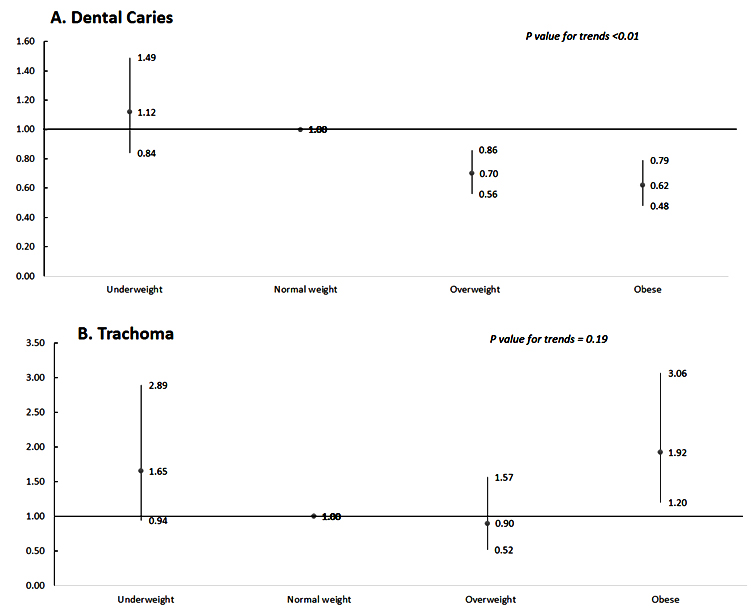1. Broyles ST, Denstel KD, Church TS, et al. The epidemiological transition and the global childhood obesity epidemic. Int J Obes Suppl. 2015; 5(Suppl 2): S3-S8. doi: 10.1038/ijosup.2015.12
2. Zhang S, Man Lo EC, Liu J, Chu CH. A review of the dental caries status of ethnic minority children in China. J Immigr Minor Health. 2015; 17(1): 285-297. doi: 10.1007/s10903-013- 9916-3
3. Cleaton-Jones P, Fatti P, Bonecker M. Dental caries trends in 5- to 6-year-old and 11- to 13-year-old children in three UNICEF designated regions–Sub Saharan Africa, Middle East and North Africa, Latin America and Caribbean: 1970-2004. Int Dent J. 2006; 56(5): 294-300. doi: 10.1111/j.1875-595X.2006. tb00104.x
4. Christian B, Blinkhorn AS. A review of dental caries in Australian Aboriginal children: The health inequalities perspective. Rural Remote Health. 2012; 12(4): 2032.
5. Wang LH, Wang B, Wang HY, et al. Prevalence of trachoma in rural primary school children in Tengzhou City of Shandong Province in China [In Chinese]. Zhonghua Yan Ke Za Zhi. 2010; 46(5): 395-399. doi: 10.3760/cma.j.issn.0412-4081.2010.05.004
6. Alemayehu M, Koye DN, Tariku A, Yimam K. Prevalence of active trachoma and its associated factors among rural and urban children in Dera Woreda, Northwest Ethiopia: A comparative cross-sectional study. Biomed Res Int. 2015; 2015: 570898. doi: 10.1155/2015/570898
7. Mengistu K, Shegaze M, Woldemichael K, Gesesew H, Markos Y. Prevalence and factors associated with trachoma among children aged 1-9 years in Zala district, Gamo Gofa Zone, Southern Ethiopia. Clin Ophthalmol. 2016; 10: 1663-1670. doi: 10.2147/OPTH.S107619
8. Yao Y, Ren X, Song X, et al. The relationship between dental caries and obesity among primary school children aged 5 to 14 years. Nutr Hosp. 2014; 30(1): 60-65. doi: 10.3305/ nh.2014.30.1.7552
9. Vázquez-Nava F, Vázquez-Rodríguez EM, Saldívar-González AH, Lin-Ochoa D, Martinez-Perales GM, Joffre-Velázquez VM. Association between obesity and dental caries in a group of preschool children in Mexico. J Public Health Dent. 2010; 70(2): 124-130. doi: 10.1111/j.1752-7325.2009.00152.x
10. Honne T, Pentapati K, Kumar N, Acharya S. Relationship between obesity/overweight status, sugar consumption and dental caries among adolescents in South India. Int J Dent Hyg. 2012; 10(4): 240-244. doi: 10.1111/j.1601-5037.2011.00534.x
11. Chen W, Chen P, Chen SC, Shih WT, Hu HC. Lack of association between obesity and dental caries in three-year-old children. Zhonghua Min Guo Xiao Er Ke Yi Xue Hui Za Zhi. 1998; 39(2): 109-111.
12. D’Mello G, Chia L, Hamilton SD, Thomson WM, Drummon BK. Childhood obesity and dental caries among paediatric dental clinic attenders. Int J Paediatr Dent. 2011; 21(3): 217-222. doi: 10.1111/j.1365-263X.2011.01112.x
13. Granville-Garcia AF, de Menezes VA, de Lira PI, Ferreira JM, Leite-Cavalcanti. A Obesity and dental caries among preschool children in Brazil. Rev Salud Publica (Bogota). 2008; 10(5): 788-795. doi: 10.1590/S0124-00642008000500011
14. Wu L, Chang R, Mu Y, et al. Association between obesity and dental caries in Chinese children. Caries Res. 2013; 47(2): 171-176. doi: 10.1159/000344017
15. Farsi DJ, Elkhodary HM, Merdad LA, et al., Prevalence of obesity in elementary school children and its association with dental caries. Saudi Med J. 2016; 37(12): 1387-1394. doi: 10.15537/smj.2016.12.15904
16. Prashanth ST, Bhatnagar S, Das UM, Gopu H. Oral health knowledge, practice, oral hygiene status, and dental caries prevalence among visually impaired children in Bangalore. J Indian Soc Pedod Prev Dent. 2011; 29(2): 102-105. doi: 10.4103/0970-4388.84680
17. Kuczmarski RJ, Ogden CL, Guo SS, et al, 2000 CDC growth charts for the United States: Methods and development. N.C.f.H. Statistics. Centers for Disease Control and Prevention; 2002. Website. http://europepmc.org/abstract/med/12043359. Accessed June 22, 2017.
18. Thylefors B, Dawson CR, Jones BR, West SK, Taylor HR. A simple system for the assessment of trachoma and its complications. Bull World Health Organ. 1987; 65(4): 477-483.
19. Liang YJ, Xi B, Song AQ, Liu JX, Mi J. Trends in general and abdominal obesity among Chinese children and adolescents 1993-2009. Pediatr Obes. 2012; 7(5): 355-364. doi: 10.1111/j.20476310.2012.00066.x
20. Song Y, Wang HJ, Dong B, Ma J, Wang Z, Agardh A. 25- year trends in gender disparity for obesity and overweight by using WHO and IOTF definitions among Chinese school-aged children: A multiple cross-sectional study. BMJ Open. 2016; 6(9): e011904. doi: 10.1136/bmjopen-2016-011904
21. Wang HY, Petersen PE, Bian JY, Zhang BX. The second national survey of oral health status of children and adults in China. Int Dent J. 2002; 52(4): 283-290. doi: 10.1111/j.1875- 595X.2002.tb00632.x
22. Shen A, Zeng X, Cheng M, Tai B, Huang R, Bernabé E. Inequalities in dental caries among 12-year-old Chinese children. J Public Health Dent. 2015; 75(3): 210-217. doi: 10.1111/jphd.12091
23. Hu A, Cai X, Qiao L, Wang N. Comparison of visual impairment caused by trachoma in China between 1978 and 2006. Zhonghua Yan Ke Za Zhi. 2015; 51(10): 768-772.
24. Ren Z, Liang QF, Guo S, Zhou YM, Li R, Sun XG. Prevalence and risk factors for trachoma in primary school children in Datong City in China [In Chinese]. Zhonghua Yan Ke Za Zhi. 2008; 44(6): 507-510. doi: 10.3321/j.issn:0412- 4081.2008.06.007
25. Xue W, Lina Lu, Zhu J, et al. A cross-sectional populationbased survey of trachoma among migrant school aged children in Shanghai, China. Biomed Res Int. 2016; 2016: 8692685. doi: 10.1155/2016/8692685
26. Wang N, Deng S, Tian L. A review of trachoma history in China: research, prevention, and control. Sci China Life Sci. 2016; 59(6): 541-547. doi: 10.1007/s11427-016-5056-z
27. Scientific Advisory Committee on Nutrition: Carbohydrates and Health. London: T.S. Office, Editor; 2015.






